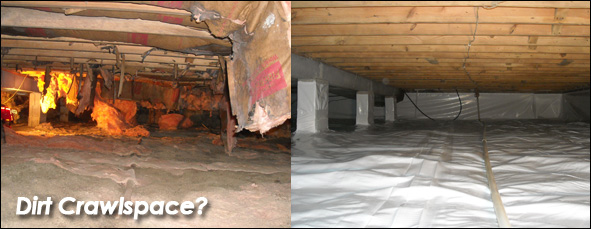
What is wrong with a dirt crawl space?
Homes that were built with crawl space foundations became very popular after World War II when there was a huge demand for new and more affordable homes. Crawl spaces could be built faster and cheaper than basements.
The problem with a dirt crawl space is that they are prone to high humidity levels, which can lead to many related problems such as mold growth, dry rot, structural damage, and poor indoor air quality. In an attempt to control moisture in the crawl space, local building codes all across the U.S. started requiring that crawlspaces be built with vents and a vapor barrier over the floor.
The vapor barrier, usually a 6mil polyethylene plastic covering the entire floor of the crawl, overlapped a few inches at the seams, and sometimes was sealed with tape. The vapor barrier was supposed to prevent ground moisture from evaporating into the crawl.
After many years and millions of dollars spent annually in crawl space mold remediation and structural repairs, contractors and builders began to realize that there was something very wrong with a building code requirements. Mold, dry rot and structural damages in vented, dirt crawl spaces are so prevalent in the U.S. that industry specialists call it a true housing epidemic.
What we learned about crawlspace vents?
As building scientists took a closer look of how crawl spaces work, they realized that the only source of moisture being addressed in these requirements was the ground moisture, which was being covered with the crawl space vapor barrier.
They forgot to account for water seeping through concrete block walls and crawlspace vents which was their approach to control moisture in the air. Not only the do the vents fail to address condensation, but they make the humidity problem much worse.
During the summer months, differences in temperature between the crawl space and the outside air cause the relative humidity levels that are present in the outside air to rise as it enters the cooler crawl space. For each degree the air is cooled, there is a 2.2 percent increase in relative humidity levels. Therefore, a 10 degree temperature difference between the outside and the crawl will mean over 20 percent rise in relative humidity levels. The warmer it gets outside, the more moisture in the air of the crawlspace.
Every time the relative humidity levels rise above 65 percent in the crawl space, mold is likely to develop and grow, which overtime can compromise your homes structural integrity. This is not even addressing indoor air quality and energy efficiency of your home.
Crawl Space Encapsulation
Several studies conducted by many reputable organizations, including Advanced, Energy, Habitat for Humanity, and Building Science Corp. conclude that the best way to treat crawl spaces in new and existing buildings is through a process called encapsulation.
The Crawl Space Encapsulation Process contains three main procedures:
1 Installing a heavy-duty crawl space plastic liner, which is used to seal both ground and foundation walls to address moisture intrusion from these areas. The liner is fastened and sealed to the wall; and taped at every seam.
2 . Sealing off the vents and outside air to prevent unconditioned air from entering the crawlspace.
3 . Adequate conditioning or dehumidification to address condensation.
Crawl space encapsulation is not only the proven method to control moisture, it is also proven to improve the homes overall energy efficiency an average of 10 to 20 percent, by stopping the infiltration of unconditioned air from the outside.
